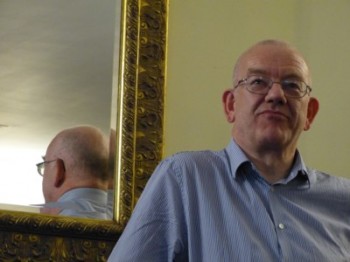We are developing the social individualist meta-context for the future. From the very serious to the extremely frivolous... lets see what is on the mind of the Samizdata people.
Samizdata, derived from Samizdat /n. - a system of clandestine publication of banned literature in the USSR [Russ.,= self-publishing house]
|
I have long admired the libertarian historian and activist Stephen Davies, my previous posting here about him being this one, in connection with a talk he recently gave to Libertarian Home, in the superbly opulent setting of the Counting House‘s Griffin Room, in the City of London.
Here is a photo of Davies that I took that night:

Here is another, together with a photo of someone else also photoing him.
The Davies talk was predictably excellent, and this on a day when he had also given another talk elsewhere in southern England somewhere, to a bunch of sixth formers. I know this because I happened to share a tube journey with Davies afterwards, during which we talked about, among other things, his day, and why he was so very tired. I don’t recall where this other talk was, but do recall that it was definitely out of London and that Davies also organised for three other speakers to be present, as well as himself speaking. All this being part of the networking and speechifying enterprise that Davies masterminds from the IEA, along with his IEA colleague Christiana Hambro. LLFF2013 was but a London manifestation of a nationwide libertarian outreach programme.
The way Davies seems to operate is that he has a number of set-piece performances on particular themes, each of which he delivers pretty much off the cuff, with almost intimidating fluency but which he will typically have done several times before you get to hear it. So, when a particular audience assembles, they get to choose from a menu. There’s that history of libertarianism talk, which Davies did for Libertarian Home, having previously done it for the Essex University Libertarians and presumably for plenty of others besides. There is a healthcare talk, which I heard Davies do at LLFF2013, which he also did for those sixth-formers earlier in the day of the Libertarian Home performance. And there are several more of course, which I also asked him about, during that tube journey. I know. He was by then just about dead on his feet, but just sitting there and not asking such things would have felt even ruder than picking his exhausted brain.
A particular favourite of Davies himself, and of me now that I have heard about it, concerns history dates.
→ Continue reading: Steve Davies supplies some different and better history dates
Rob Fisher’s posting here a while back entitled Open source software v. the NSA reminded me that on April 26th, in my home, Rob Fisher gave a talk about open source software. I flagged this talk up beforehand in this posting, but have written nothing about it since. I don’t want to get in the way of whatever else Rob himself might want to write here on this subject, but I do want to record my appreciation of this talk before the fact of it fades from my faltering memory and I am left only with the dwindling remnants of what I learned from it.
My understanding of open source software, until Rob Fisher started putting me right, was largely the result of my own direct experience of open source software, in the form of the Linux operating system that ran on a small and cheap laptop computer I purchased a few years back. This programme worked, but not well enough. Missing was that final ounce of polish, the final five yards, that last bit of user friendliness. In particular I recall being enraged by my new laptop’s inability properly to handle the memory cards used by my camera. Since that was about half the entire point of the laptop, that was very enraging. I wrote about this problem at my personal blog, in a posting entitled Has the Linux moment passed?, because from where was sitting, then, it had. I returned with a sigh of relief to using Microsoft Windows, on my next small and cheap laptop.
I then wrongly generalised from my own little Windows-to-Linux-and-then-back-to-Windows experience, by assuming that the world as a whole had been having a similar experience to the one I had just had. Everyone else had, like me, a few short years ago, been giving Linux or whatever, a try, to save money, but had quickly discovered that this was a false economy and had returned to the fold, if not of Microsoft itself, then at least of software that worked properly, on account of someone having been paid to make it work properly.
The truth of the matter was clarified by Rob Fisher, and by the rest of the computer-savvier-than-I room, at that last-Friday-of-April meeting. Yes, there was a time a few years back when it seemed that closed source software looked like it might be making a comeback, but that moment was the moment that quickly passed. The reality was and remains that the open source way of doing things has just grown and grown. All that I had experienced was the fact that there has always been a need for computer professionals to connect computer-fools like me with all that open source computational power, in a fool-proof way. But each little ship of dedicated programming in each gadget floats on an ever expanding and deepening ocean of open source computing knowledge and computing power.
→ Continue reading: What I learned from Rob Fisher’s talk about open source software
My last Friday of the month meetings are now under way again, and they are accomplishing everything I here hoped they would. Worthwhile thoughts are being thought. I am making new friends. I am also reconnecting with friends from way back, which is a bonus I should have seen coming but did not. The most recent meeting was especially fine. About it I will surely be saying more, by and by.
Meanwhile, however, I continue making my small living room into the best place that it can be for these evenings. What I need next is one of these:

I came across that in a Pret a Manger (it seems they allow you to forget about accents) near Waterloo Station. The Wi-Fi there proved unsatisfactory for my purposes, but the above item of seating is exactly the sort of thing I now want.
It seats three in comfort, as do many sofas on sale these days. But it also has two other features which seem to be harder to come by.
First, unlike most the sofas I am now looking at, this one is not too deep from front to back. This comes partly from this sofa not also being a sofa-bed. I already have a sofa-bed. The last thing I need is another sofa-bed. A sofa(-bed) that sticks out too far into my small living room is no good to me. But many sofas that are not sofa-beds also stick out into the room far too much for my purposes. A sofa like the one above is what I need.
Second, the above sofa does not have wide and rather squishy arm rests. Instead it has narrow wooden ones. So just as it economises on depth space, it also makes the most of sideways space, space that I need every inch of for more seating.
Such wooden arm rests, in between meetings, can be easily used to rest a big plank on, which is helpful for when I am battling with paperwork, which I am, now and always. Also, during meetings, the wooden arms would be good for resting drinks on, in the way that big squishy arm rests are not.
Nevertheless, I would definitely consider something which is the same shape as the sofa in the picture, but without any arm rests at all. The important thing about this sofa is how well it uses space, compared the usual lumbering monster sofas that are to be seen in every furniture shop or furniture website in such abundance. Pret a Manger presumably have a problem not unlike mine, that made them want what I want. I want one sofa that helps me get as many people into my small living room as I can. They want as many sofas as possible, to get as many people as they can get into a larger space.
The sofa I seek doesn’t have to be any particular colour, or in as good condition as the one above. Rather battered would probably be rather good, because cheaper. It just needs to be that particular sort of shape, or as near to it as I can find.
So, can any of my London friends, or for that matter anyone reading this and living in London, or, really, just anyone, help? All relevant information would be gratefully received. (Comment, or email me by going here and clicking where it says Contact, top left. (That needs to be a slightly complicated process, to deter spammers.))
In order to rescue this posting from being an unadulterated personal advert, let me adulterate it with a broader observation about modern life. Notice how much harder it would have been for me to get across what kind of sofa I am seeking, had I not been able, at zero additional cost to me, to include a photo in this posting of what I am looking for.
→ Continue reading: On the sort of sofa I am looking for – and on the impact of digital photography on trade
At around midday today I caught Ed Davey MP babbling away on the telly about how 97 percent of climate scientists agree with him about the need to wreck the British economy and treble our fuel bills by making carbon illegal, or whatever. The BBC person present complained that Davey wasn’t doing nearly as much to wreck the British economy and treble our fuel bills as he should have been doing, and that what he was saying was merely bluster to comfort greeny true believers. It would certainly be nice to think so.
Peter Lilley MP, also present, had plenty to say about these absurd claims, but the word – just the one word – that he used that I remember most fondly was: Tosh.
Later in the day, on a tube train, I learned of better British economy and energy bill news, in the form of this City A.M. front page:

Here is the front page story.
Quote:
THE UK’s shale gas industry was given a huge boost yesterday after one exploration firm massively lifted its estimate of the amount of untapped gas resources in the north of England.
Initial studies by IGas – one of the few companies with permission to explore UK shale reserves – have shown that reserves in its sites in the Bowland exploration area could hold up to 172.3 trillion cubic feet of shale gas – nearly 20 times higher than previous estimates.
My favourite paragraph of this story is this one:
But there has been opposition from green groups, who say it will reduce investment in renewable energy, and claim the hydraulic fracturing method used to recover the gas may cause earth tremors.
Anything that reduces invetment in “renewable” energy, which is the stupid kind, is all to the good. As for those earth tremors, bring them on.
City A.M. Editor Allister Heath starts what he has to say about Britain’s shale bonanza with this question:
What are we waiting for?
Waiting, presumably, for the likes of Ed Davey MP to be dumped into the dustbin of history where they belong.
Incoming from Rob Fisher (to whom I owe him a blog posting about this talk that he gave at my home a while back – short version: it was very good):
Finally I found a video that explains to my satisfaction what using Google Glass is like. It’s a display that you wear, that uses clever optics to give the appearance of looking at a 25 inch screen 8 feet away.
Parts of this video are welcome-to-the-future moments.
By the way, these voice commands already work on your phone; tap the microphone symbol top right and say something like “wake me up at 8am”.
My phone being the Google Nexus 4 that I have been going on about lately, for example in the previous posting here.
I won’t be watching this video in the immediately immediate future as I have other things to be getting on with. But I definitely will very soon.
What Rob says about voice commands is interesting, I think. I have long suspected that a big computer leap would occur when we stopped communicating with computers by typing on them, and instead just talked to them. “Jeeves, what’s that thingy where the thingamajig I was talking about yesterday is yellow instead of black?” “Do you perhaps mean this, sir?” “Yes, that’s the thing. You’re a genius Jeeves!” “One does one’s best sir.” Etc.
So it seems that it is possible to create a functional firearm with a 3D printer after all… awesome.
Ammunition may be a tad harder but where there is a will, there is a way.
If you want to introduce someone to libertarian thinking, encourage them to try this experiment. Spend a few days reading nothing but technology news. Then spend a few days reading nothing but political news. For the first few days they’ll see an exciting world of innovation and creativity where everything is getting better all the time. In the second period they’ll see a miserable world of cynicism and treachery where everything is falling apart. Then ask them to explain the difference.
– Andrew Zalotocky, commenting on this, here, about #HackedOff, many weeks ago.
I had this all ready to be an SQotD right after it first got said, but then another SQotD happened, and I forgot about it. Today, I chanced upon it again.
A typical reaction to global warming skepticism is to point to all the institutions that endorse global warming and argue that this would require a grand conspiracy if global warming were false.
I argue that all that is needed is for incentives to align in a certain direction. The awarding of grants, the publication of papers and the media attention all point in one direction and there is positive feedback between them.
As reported in the New York Times, Diederik Stapel literally made up results of psychological experiments that were never done. It is not necessary to go quite that far.
Fraud like Stapel’s — brazen and careless in hindsight — might represent a lesser threat to the integrity of science than the massaging of data and selective reporting of experiments. The young professor who backed the two student whistle-blowers told me that tweaking results — like stopping data collection once the results confirm a hypothesis — is a common practice. “I could certainly see that if you do it in more subtle ways, it’s more difficult to detect,” Ap Dijksterhuis, one of the Netherlands’ best known psychologists, told me.
Journals and reviewers can play a part:
If Stapel was solely to blame for making stuff up, the report stated, his peers, journal editors and reviewers of the field’s top journals were to blame for letting him get away with it. The committees identified several practices as “sloppy science” — misuse of statistics, ignoring of data that do not conform to a desired hypothesis and the pursuit of a compelling story no matter how scientifically unsupported it may be.
The adjective “sloppy” seems charitable. Several psychologists I spoke to admitted that each of these more common practices was as deliberate as any of Stapel’s wholesale fabrications. Each was a choice made by the scientist every time he or she came to a fork in the road of experimental research — one way pointing to the truth, however dull and unsatisfying, and the other beckoning the researcher toward a rosier and more notable result that could be patently false or only partly true. What may be most troubling about the research culture the committees describe in their report are the plentiful opportunities and incentives for fraud. “The cookie jar was on the table without a lid” is how Stapel put it to me once. Those who suspect a colleague of fraud may be inclined to keep mum because of the potential costs of whistle-blowing.
So there are incentives to take an easy path of painting a simple, neat picture because it is more persuasive and saleable.
Stapel did not deny that his deceit was driven by ambition. But it was more complicated than that, he told me. He insisted that he loved social psychology but had been frustrated by the messiness of experimental data, which rarely led to clear conclusions. His lifelong obsession with elegance and order, he said, led him to concoct sexy results that journals found attractive. “It was a quest for aesthetics, for beauty — instead of the truth,” he said.
…
What the public didn’t realize, he said, was that academic science, too, was becoming a business. “There are scarce resources, you need grants, you need money, there is competition,” he said. “Normal people go to the edge to get that money. Science is of course about discovery, about digging to discover the truth. But it is also communication, persuasion, marketing. I am a salesman.
It is not just money; the rewards are the respect and admiration of one’s peers. In my talk on open source software on Friday I mentioned that this is one of the reasons individuals give away their source code or donate their time to open source projects. It feels good to make something that others find impressive.
I am lucky enough to work in software. There, the most aesthetically pleasing solution is usually the best one. And software can not easily be faked; it becomes apparent very quickly if it does not work. I can imagine software that appears to do what it claims to do without actually doing it, such as an encryption program that leaks your secrets. Open source software has largely solved this problem. In fact, science could learn a lot from open source software.
H/T Watts Up With That?
My next Last Friday of the Month speaker, this coming Friday (April 26) will be Samizdata’s own Rob Fisher, who has emailed me thus:
These are my notes for the ‘introduction’ section of my talk. I think this should give you a flavour of what to expect:
I am going to talk about open source software.
I am calling it “open source” but as we will see there are variations on that theme.
I will talk about the history because it tells us things about the motivations of the people who work on open source software.
I will also talk about the nature of software in general, to put open source in context.
I want to talk about what it is like to develop software, and to develop open source software and proprietary software. I have done a little of the former and a lot of the latter – developing proprietary software is my day job.
And I will tell you about how open source looks today, what kinds of software are open source, who is developing it, who is using it and how an open source project is run.
And I will talk about ways I think open source software is saving the world (from a variety of bad things that would happen without it).
I don’t have a grand thesis to share, no big new idea. What I’m talking about is mostly well known, but my aim is to provide an overview so we can think about what it all means in a broader economic sense, and I’ll share the few thoughts I have about that.
I am looking forward to this a lot, because I expect to learn a lot. I particularly like the sound of that “saving the world” bit.
This stuff is likely to be central to many of the most vexed political and legal arguments of the next few decades. Intellectual property gets ever hotter as a topic, as they continue to lengthen the number of years it lasts. And as “3D printing” gets into its stride, that is adding a whole new dimension of relevance to such arguments. Open Source manufacturing, anyone?
It is already clear from emailed acceptances that there will be a good turnout. There is room for it to be slightly better, but only slightly. Email me soon (go here and click on “Contact”), if you would like to attend.
James Delingpole has a nice posting about a recent excellent performance by Peter Lilley, the Tory MP who seems, unlike many of them, to have retained a large measure of common sense. This is what Mr Lilley said recently about the constant run of conferences held to discuss environmental issues:
“Those whom the gods wish to destroy they first make mad. One of the early signs of madness is an indulgence in compulsive displacement activity, which could not be a better description of the whole COP process. Tens of thousands of people are displaced across the globe to an environment where they are cut off from reality and the rest of the world, where they can indulge themselves in demonstrating their lack of realism and reality, and where the original objective of obtaining a legally binding agreement between nations to reduce worldwide emissions has itself been displaced by the alternative objective of reaching an agreement to meet again—and to agree to reach an agreement at some distant future time. That is displacement activity on a massive scale, and it involves a massive degree of hypocrisy, given the huge emissions incurred by these eco-warriors as they swan across the globe in jets and hire fleets of limousines, so emitting more CO2 than a small African country.”
It is Earth Day today, by the way.
Since the Cyprus crisis the price of Bitcoins has rapidly increased. Felix Salmon wrote one of the better articles about this. But the article has its problems.
He opens by talking about someone who lost all his Bitcoins when his computer was hacked. This is avoidable by storing funds in an off-line wallet, which is just a file containing a private key used to transmit funds. It is not much different from storing gold, except that it takes up less space, backups can be made, a thief would need to both steal your wallet and know your password, and it is possible to pay money in to an off-line wallet. You only need to expose your wallet to the Internet to pay money out of it. All this requires a certain amount of skill and knowledge but so does any method of storing value.
Salmon uses the word “anonymous” carelessly. Bitcoin is not anonymous and not intended to be. It is pseudonymous. Every transaction is visible, and it is possible for the government to find out, for example, which bank account was used to buy some Bitcoins. You can probably take steps to make this so expensive that law enforcement could not afford it. But that is a practical point, not a mathematical one, and it would be a mistake to think that anonymity is built in.
Salmon complains that Bitcoin needs too much technical expertise to use. But not everyone need use Bitcoins directly for them to serve as a store of value, any more than people need to handle physical gold themselves. That one has the option to do so if one does not trust others is nice, but trusting others for convenience is possible too. If Bitcoin were widely adopted, I would expect to see secondary currencies backed by Bitcoin to be used as cash, and the equivalent of Visa and Paypal to be implemented by someone.
Salmon points out that the value of Bitcoin is very volatile and closely tracks media coverage of it. This is because there is a fixed supply (there will only ever be 21 million Bitcoins) and new people are still discovering the currency. After every media report the number of people who want Bitcoins increases. Once everyone knows about it who would want to buy it, the price should settle down as the overall demand for money is not so volatile.
Salmon’s main point is that Bitcoin is doomed to fail because as it is adopted its price will increase rapidly, which hyperdeflation will mean no-one spends it. But such a situation can not persist; as soon as the price settles spending will resume.
Although I am optimistic, there are plenty of ways it could fail. Something better might come along, or governments may attempt to put a stop to it and may succeed enough to make it fail.
Or in twenty years’ time you could find yourself having bought one 21-millionth of the global money supply for a very good price. 😉
It seems that another pandemic panic may be about to strike. (Thank you Instapundit, who seems a bit panic-stricken himself.)
It so happens that I have recently acquired and have been reading Matt Ridley’s excellent book, The Rational Optimist, which Johnathan Pearce has often blogged about here, in this posting, for example. (Here is a piece by Ridley, defending his book against Monbiot.)
And it further so happens that The Rational Optimist contains a very interesting passage (pp. 308-310), which I already had in mind to flag up here, even before this latest news of another flu outbreak, about the spread of infectious diseases, which explains why any pandemic panic that now materialises is likely once again to be greatly exaggerated:
In the 2000s influenza, too, proved to be a paper tiger. H5N1 strains of the virus (‘bird flu’) jumped into human beings via free-range ducks on Chinese farms and, in 2005, the United Nations predicted five million to 150 million deaths from bird flu. Yet, contrary to what you have read, when H5N1 did infect human beings it proved neither especially virulent nor especially contagious. It has so far killed fewer than 300 people worldwide. As one commentator concluded: ‘Hysteria over an avian flu pandemic has been very good for the Chicken Little media, authors, ambitious health officials, drug companies … But even as many of the panic-mongers have begun to lie low, the vestiges of hysteria remain – as do the misallocations of billions of dollars from more serious health problems. Too bad no one ever holds the doomsayers accountable for the damage they’ve done.’
I suspect this is too strong, and that flu may yet mount a serious epidemic in some form. But the H1N1 swine flu epidemic of 2009 that began in Mexico also followed the usual path of new flu strains, towards low virulence – about one death for every 1,000-10,000 infected people. This is no surprise. As the evolutionary biologist Paul Ewald has long argued, viruses undergo natural selection as well as mutation once established in a new species of host and casually transmitted viruses like flu replicate more successfully if they cause mild disease, so that the host keeps moving about and meeting new people. A victim lying in a darkened room alone is not as much use to the virus as somebody who feels just well enough to struggle into work coughing. The modern way of life, with lots of travel but also rather more personal space, tends to encourage mild, casual-contact viruses that need their victims to be healthy enough to meet fresh targets fleetingly. It is no accident that modern people suffer from more than 200 kinds of cold, the supreme viral exploiters of the modern world.
If this is so, why then did H1N1 flu kill perhaps fifty million people in 1918? Ewald and others think the explanation lies in the trenches of the First World War. So many wounded soldiers, in such crowded conditions, provided a habitat ideally suited to more virulent behaviour by the virus: people could pass on the virus while dying. Today you are far more likely to get the flu from a person who is well enough to go to work than one who is ill enough to stay at home.
Of course the pessimists could be right, in this or that particular instance. And of course we here are very pessimistic about the future course of the world’s current financial crisis. That is surely going to get far worse before it gets much better. I recall reporting here on a debate on that subject, where the other side was taking it for granted that the crisis that had just happened was now over and done with, and the only question concerned how best to “manage the recovery”. We here regard the people who talked like that, then, as the Chicken Little Panglossian tendency.
And Matt Ridley himself is careful to include doubts about future flu outbreaks maybe not all being so un-apocalypctic. “Flu may yet mount a serious epidemic in some form.”
Nevertheless, interesting. And it will be interesting to see how this latest flu flare-up plays out.
|
Who Are We? The Samizdata people are a bunch of sinister and heavily armed globalist illuminati who seek to infect the entire world with the values of personal liberty and several property. Amongst our many crimes is a sense of humour and the intermittent use of British spelling.
We are also a varied group made up of social individualists, classical liberals, whigs, libertarians, extropians, futurists, ‘Porcupines’, Karl Popper fetishists, recovering neo-conservatives, crazed Ayn Rand worshipers, over-caffeinated Virginia Postrel devotees, witty Frédéric Bastiat wannabes, cypherpunks, minarchists, kritarchists and wild-eyed anarcho-capitalists from Britain, North America, Australia and Europe.
|






